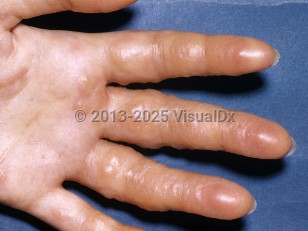Prehospital agent identification may be achieved prior to casualty arrival at the hospital, but in some jurisdictions, all that will be known is that an exposure occurred. Decontamination must occur almost immediately (usually at the scene, and needs to occur nearly immediately after exposure for maximal benefit).
If agent identification has not been achieved prior to casualty arrival at the hospital, and there is some uncertainty regarding exposures due to nonspecific symptoms or concern for use of multiple agents, clinical staff should get expert consultation (institutional, local, or state toxicology services) regarding the risks / benefits of empiric use of various chemical agent antidotes.
Of the vesicants, sulfur mustard has been used the most frequently. Tens of thousands of soldiers and civilians were exposed during the Iraq-Iran conflict in the 1980s. Sulfur mustard can cause delayed symptoms and signs (hours) and can also suppress hematologic cell lines.
Organ involvement, severity of presenting symptoms, and time of symptom onset postexposure will depend on ambient conditions, agent involved, exposure dose, and preexposure comorbidities.
Sulfur Mustard:
- Sulfur mustard, also known as mustard gas, HD, yellow cross, and yperite, was named for its mustard-like odor and taste and its yellow-to-dark brown color. (Note: It can also have an onion or garlic odor and taste.) There is no antidote for mustard gas.
- The freezing point for mustard is 57°F (13.9°C). This freezing point can be lowered if it is mixed with another agent such as lewisite. Mustard is not very volatile and relies on heat to be vaporized. However, release would probably be as an aerosol or droplets, making vaporization unnecessary. The LD50* of mustard is 100 mg/kg. This amount would be about 1-1.5 teaspoons for an average adult or enough to cover 25%-50% of the total body surface.
- Lewisite, also known as L, is an arsenical. Lewisite is a colorless, oily liquid in its pure form that may smell like geraniums, and it has an amber-to-black color in less pure forms. Dimercaprol (British anti-lewisite) is a chelating antidote and should be administered as soon as possible after exposure.
- Vesication from percutaneous exposure is caused by 14 μg of liquid lewisite. The blister fluid is not harmful, but it does contain arsenic. Lewisite's LCt50** by inhalation is 1500 mg × min/m3.
- There is little documentation regarding the effects of phosgene oxime, also known as CX, on humans. Although it is frequently classified as a vesicant, it does not produce blisters. Instead it is really an urticant, producing skin wheals similar to a nettle sting. There is no antidote for phosgene oxime.
- Phosgene oxime is a colorless, crystalline solid or, more typically, a yellow to brown liquid that can penetrate clothing and rubber. Phosgene oxime can be mixed with nerve agents to promote faster absorption of the nerve agent.
- LCt50** by inhalation is 1500-2000 mg × min/m3, and the LD50* for skin exposure is about 25 mg/kg.
**LCt50 (L = lethal, C = concentration of vapor [mg/m3], t = exposure time [minutes]) is the concentration of a chemical agent exposure by inhalation that causes death in 50% of unprotected people.



